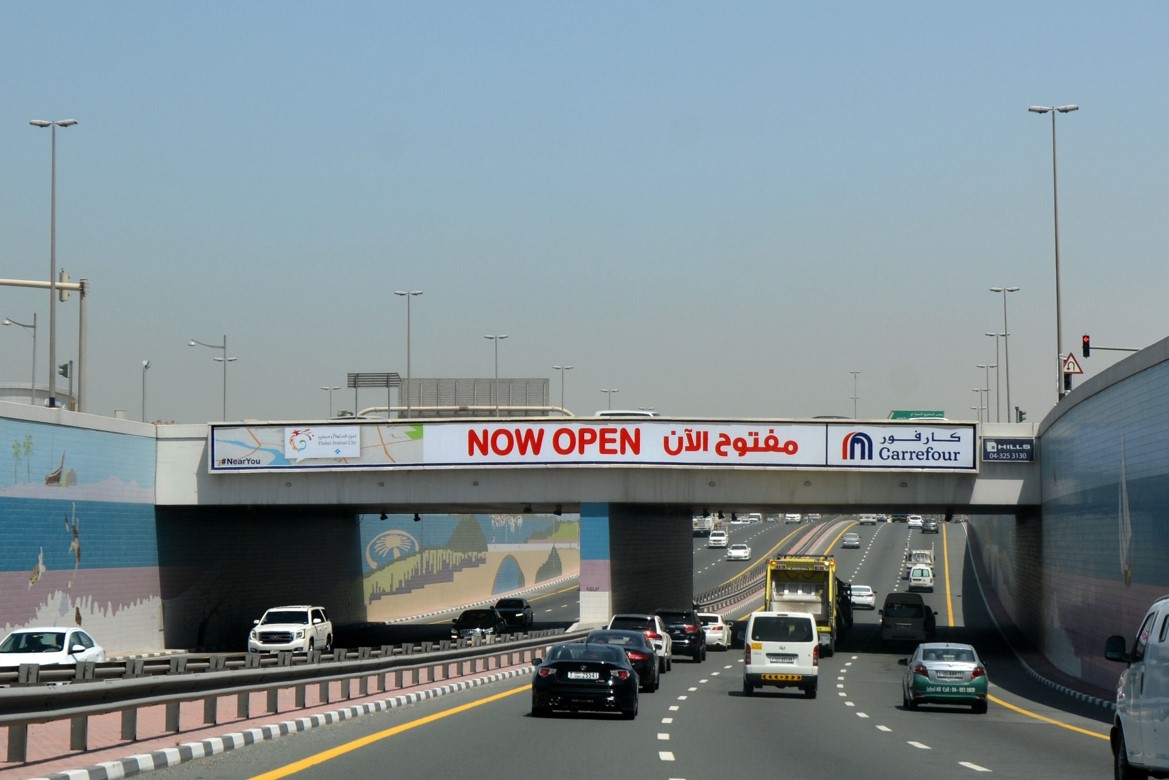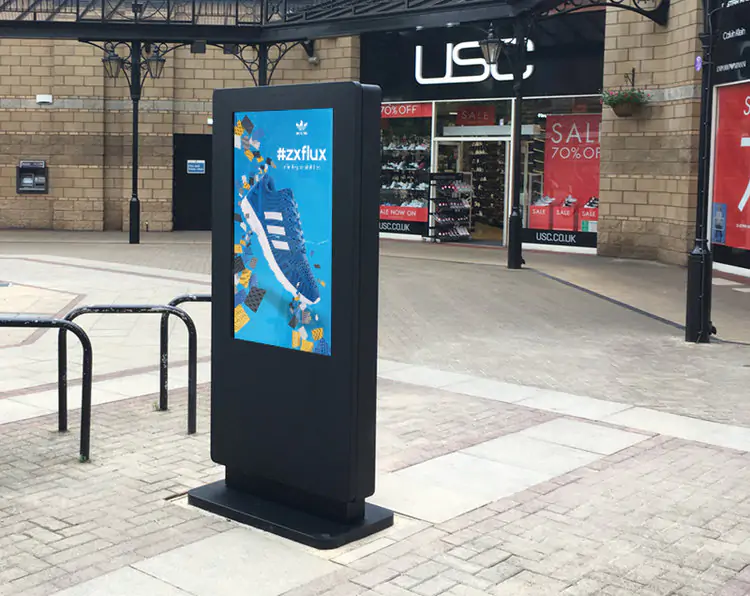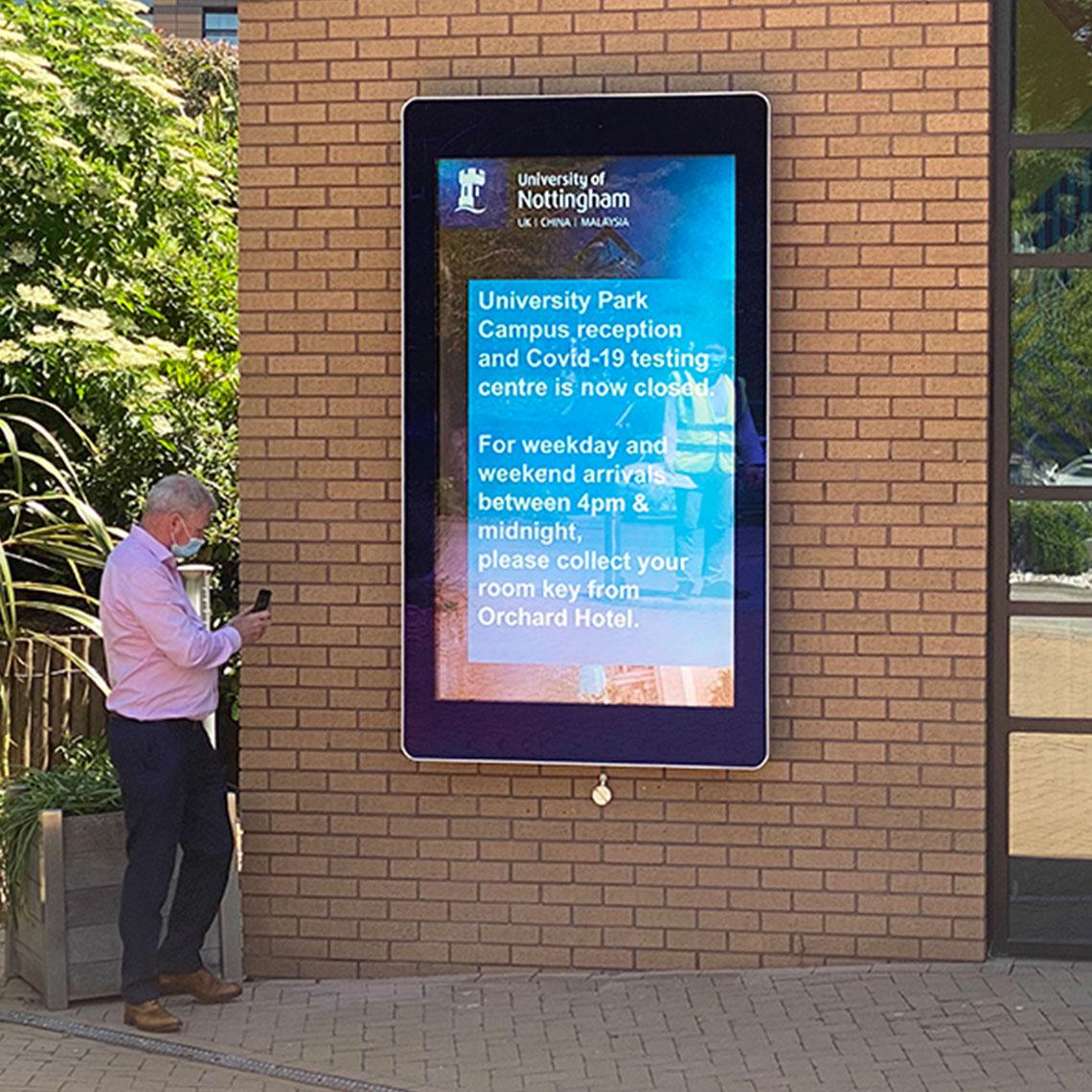Welcome to an in-depth exploration of the 11 distinct types of outdoor advertising. In today’s dynamic marketing landscape, outdoor advertising remains a pivotal strategy for businesses aiming to enhance brand recognition and reach a wider audience.
We’re diving into a universe where billboards wink, bus stops chat, and even elevators can’t keep their “screens” shut.
According to Statista, the global outdoor advertising market is expected to reach $40.6 billion by 2024. That’s a lot of eyeballs and even more potential customers!

Each type offers its own unique advantages, tailored to specific marketing objectives and target demographics. Dive into this comprehensive guide to understand how these diverse advertising methods can effectively elevate your brand’s presence in the public domain.”
AIScreen deserves a standing ovation for revolutionizing this space with cutting-edge technology. It is considered to be the one of the best Outdoor Advertising Companies in the world. So, buckle up as we journey through “11 Types of Outdoor Advertising That Works.”
Short Summary
- The article explores the multifaceted world of outdoor advertising, highlighting its resilience in a digital age where ad-blocking is common.
- It delves into various types of outdoor advertising, from traditional billboards to high-tech options like digital displays and augmented reality, discussing their pros, cons, and costs.
- The piece emphasizes the importance of strategic location and audience targeting.
- Despite its effectiveness, outdoor advertising faces challenges but remains a potent tool for brand visibility and engagement.
What Is Outdoor Advertising?
Outdoor advertising represents a critical component in the multifaceted domain of marketing strategies. This form of advertising is designed to reach consumers in public spaces through various platforms such as billboards, transit vehicles, and other outdoor digital billboards structures.

Unlike digital advertising, which often competes for attention in a cluttered online environment, outdoor advertising offers a less intrusive yet highly visible avenue for conveying a message.
It capitalizes on location-based targeting to capture the attention of potential customers during their daily activities. To learn more, read our 11 World’s Largest Outdoor Advertising Companies article.
11 Types Of Outdoor Advertising That Work
Let’s delve deeper into each of these five types of outdoor advertising, expanding on their unique attributes, advantages, and potential drawbacks.
Digital Billboards
Billboards have been around for ages, serving as the backbone of outdoor advertising. These large structures are often strategically placed along busy roads, highways, and intersections to capture the attention of motorists and passengers.

The article emphasizes the importance of keeping the message simple and direct, as people usually have only a few seconds to absorb the information.
However, the billboard’s sheer size and visibility make it an excellent medium for brands to make a lasting impression.
Types Of Billboards
Traditional Billboards: While many marketers are gravitating towards digital and mobile platforms, traditional billboards still hold their own set of merits.
Generally more cost-effective to construct and upkeep than their digital counterparts, these billboards captivate a specific audience—motorists ensnared in traffic with little else to divert their attention.
Roaming Billboards
Roaming billboards, or mobile billboards, take the concept of outdoor advertising and put it on wheels. By placing ads on trailers or trucks that traverse bustling locales, this advertising method offers a unique way to disseminate a message or promote a product in high-traffic zones like city centers or major highways.
High-Tech Billboards
Digital billboards are the nexus where digital marketing meets outdoor advertising. Controlled by computers, these electronic displays showcase vivid images and videos, offering the flexibility to feature either static or animated content.
Businesses have the option to lease these billboards for varying durations, from short-term campaigns to long-term commitments.
Augmented Reality Billboards
Augmented Reality (AR) billboards are the next evolutionary step in outdoor advertising. Unlike traditional billboards, these high-tech marvels offer an interactive experience that can engage the audience in unprecedented ways.
By using a smartphone or AR glasses, viewers can see additional 3D content superimposed over the billboard’s display, creating a more immersive experience.
Lamp Posts For Outdoor Ads
Lamp post advertising might seem like a minor player in the outdoor advertising game, but it’s a method that should not be overlooked. These ads usually consist of banners or signs attached to lamp posts along busy streets, shopping districts, or near popular attractions.

Because they are at eye level, they can effectively capture the attention of pedestrians and slow-moving traffic. Lamp post advertising is also more affordable than billboards, making it accessible for smaller businesses.
Bridge Banners Outdoor Advertising Examples
Advertising on bridges offers a unique opportunity to capture the attention of both motorists and pedestrians. These ads are usually large banners or signs that are hung or attached to the sides or underbelly of bridges.

Given their elevated position, they are hard to miss and can be seen from great distances, making them ideal for brands looking to make a big splash.
Guerrilla Advertising
Guerrilla advertising is the maverick of outdoor advertising. It employs unconventional, often surprising tactics to create a memorable experience. This could range from flash mobs and interactive installations to graffiti and street art.
The primary aim is to create buzz and encourage social sharing, effectively amplifying the campaign’s reach beyond the initial audience.
Point of Sale Advertising
Point of Sale (POS) advertising is a specialized form of outdoor advertising that targets consumers at the exact moment they’re about to make a purchase. These ads are strategically placed near checkout counters or queues in retail stores.
The primary objective? To entice the consumer to make an impulse buy or add an additional item to their shopping cart. This form of advertising is highly effective for promoting discounted items or limited-time offers.
Retail Advertising
Retail advertising is another form of outdoor advertising that takes place within the confines of retail environments like shopping malls or individual stores. With advancements in printing technology, the options for creative displays have expanded exponentially.

From floor graphics to lift graphics, retail advertising aims to create an immersive environment that enhances the consumer’s shopping experience.
Vehicle Advertising
Vehicle advertising is like a billboard on the move. Ads are often placed on the sides of vehicles or as vinyl wraps covering the entire body. This form of advertising is particularly effective because of its mobility.
Whether it’s a taxi, a bus, or a company fleet, the ad reaches a broader audience simply by being on the move.
It’s an excellent way for businesses with multiple locations to increase brand awareness across a larger geographical area. Moreover, the constant visibility of these ads makes them hard to ignore, increasing the likelihood of them being remembered by potential customers.
Construction Advertising
Construction sites might seem like an unlikely place for advertising, but they offer unique opportunities. Protective barriers like hoardings and scaffold covers can be transformed into advertising spaces.
These ads can serve multiple purposes: they can provide a preview of the construction project, promote the companies involved, or even advertise other local businesses.

However, this form of advertising often comes with its set of rules and regulations, usually dictated by local authorities.
Interactive Kiosks Types Of Outdoor Advertising Signs
Interactive kiosks are emerging as a dynamic form of outdoor advertising that not only displays ads but also allows for real-time interaction with consumers. These kiosks can be placed in high-traffic areas like shopping malls, airports, and train stations.

They often feature touch screens, allowing users to engage with the content. For example, a kiosk might display an ad for a new smartphone and then allow users to explore its features via an interactive interface.
This form of advertising is highly engaging and can provide valuable data on consumer behavior. It’s like having a salesperson on the street, ready to interact with potential customers 24/7.
However, the cost of setting up and maintaining these kiosks can be high, and there’s always the risk of technical glitches that could disrupt the user experience.
Ambient Advertising
Ambient advertising is a creative form of outdoor advertising where the ad is integrated into the environment in a way that makes it almost a part of it. For example, an ad for a gym might be placed on an escalator’s handrail, encouraging people to take the stairs instead.
Or a coffee brand might place a giant cup and saucer on a roundabout. The key to ambient advertising is the element of surprise; it catches people off guard and makes them pay attention to something they would otherwise ignore.
This form of advertising is highly memorable and often shared on social media, giving it a potentially viral reach.
However, it requires a high level of creativity and planning and not all types of products or messages may be suitable for this form of advertising.
Outdoor Advertising Examples
Mumbai Metro Makeover: Cadbury decided to jazz up metro trains on the Versova-Andheri-Ghatkopar line to promote their new ‘Fuse’ chocolate. This strategy was particularly impactful for capturing the attention of young people between 15 and 25, given the high number of passengers on this metro line.
City Buses as Moving Billboards: In addition to trains, Cadbury also decked out buses in bustling cities like Mumbai and Bangalore. This approach not only caught the eyes of bus riders but also made an impression on pedestrians and other drivers, broadening the digital outdoor advertising campaign reach.
Classic Yet Effective: Alongside these innovative tactics, Cadbury didn’t overlook the power of traditional billboards and unipoles. They strategically placed these across multiple cities, using a consistent visual theme to reinforce brand recall.
These instances illustrate the adaptability and potency of outdoor advertising, which can be customized to suit the unique requirements and target demographics of any promotional effort.
Why Should Brands Go For Outdoor Advertising?
Outdoor advertising offers a unique blend of visibility and impact, making it a compelling choice for brands. First, it provides unparalleled reach, targeting a broad audience that includes commuters, pedestrians, and even idle drivers stuck in traffic.

Second, the larger-than-life formats, like billboards and train wraps, create a lasting impression, enhancing brand recall.
Third, it’s a versatile medium, allowing for creative executions that can range from digital displays to interactive installations.
Fourth, outdoor ads are hard to ignore or skip, unlike digital ads that can be scrolled past or blocked. Finally, they offer a high return on investment, especially when strategically placed in high-traffic areas. All these factors make outdoor advertising an effective tool in any brand’s marketing arsenal.
Who You Should Opt For Outdoor Advertising
If you’re a brand aiming for maximum visibility and engagement, outdoor advertising should be a key component in your marketing strategy. Specifically, AIScreen offers a cutting-edge solution that takes outdoor advertising to the next level.

First off, AIScreen’s digital displays are eye-catching and can be updated in real-time, allowing for dynamic content that resonates with your target audience. This is particularly beneficial for time-sensitive promotions or event-based marketing.
Second, AIScreen offers analytics capabilities, providing viewer engagement and ad performance.
This data-driven approach enables brands to fine-tune their campaigns for optimal results. Third, the platform’s interactive features can turn a passive viewing experience into an interactive one, thereby increasing engagement and recall.

Fourth, AIScreen’s digital nature makes it eco-friendlier than traditional print-based outdoor media. Lastly, the platform offers scalability, allowing brands to easily expand their campaigns across multiple locations.
For these reasons, AIScreen stands as a compelling choice for brands looking to make a significant impact through outdoors digital signage advertising refers.
How Much Does Outdoor Advertising Cost?
The cost of outdoor advertising hinges on multiple variables. The medium you opt for—be it billboards, bus wraps, or street furniture—will influence the overall expense.

Location is another critical factor; prime spots in bustling areas or high-traffic routes usually come with a higher price tag. The ad’s size and whether it’s a digital or static display also play into the cost equation.
Digital formats, particularly those with real-time updates or interactive features, often carry a premium. Campaign duration is yet another consideration; extended exposure naturally leads to increased costs.
Market competition and seasonal fluctuations can further impact pricing, making it essential to consult with advertising professionals for a customized quote.
Challenges In Outdoor Advertising
Here are all the challenges you might face in outdoor advertising:
Financial Burden: The High Cost of Visibility
Outdoor advertising, especially when it involves billboards or large-scale installations, can be a financial sinkhole.
From leasing the space to crafting the design and then maintaining the structure, the costs accumulate rapidly. For small enterprises or startups, this financial commitment can be a daunting obstacle, often making it an unsustainable option for long-term marketing strategies.
Limited Engagement
Unlike their digital counterparts, outdoor street furniture ads lack the element of immediate interaction. People might catch a glimpse of your billboard while zooming past on the freeway.

This unidirectional flow of information limits the depth of engagement a potential customer can have with your brand, making it a less effective tool for fostering meaningful connections.
Regulatory Hurdles
The world of outdoor advertising isn’t just about creativity and visibility; it’s also fraught with legal complexities. Zoning laws, permits, and a plethora of other regulations can turn the simple act of putting up a billboard into a bureaucratic nightmare.
Sustainability Concerns
In an age where sustainability is more than just a buzzword, the materials used in outdoor advertising come under scrutiny. The use of plastics, vinyl, and other non-biodegradable materials poses an environmental concern.

Brands are increasingly pressured to adopt eco-friendly materials and practices, adding yet another layer of complexity to the already intricate landscape of outdoor advertising.
OOH Full Form In Advertising
In the world of marketing, OOH is shorthand for “Out of Home,” denoting any advertising that occurs in open-air settings. This categorization sets it apart from indoor ads, such as those in newspapers or magazines, typically consumed within home or work environments.

The term “Out of Home” acts as an umbrella descriptor for a range of outdoor promotional activities, including but not limited to billboards and transit advertisements.
Though it may come across as jargon exclusive to the industry, the complete phrase “Out of Home advertising” lends a greater sense of gravitas and detail compared to its more concise counterpart, OOH.
Difference Between Hoarding and Billboard
When you’re mulling over the perfect outdoor advertising medium for your campaign, you might find yourself puzzled about the distinction between hoardings and billboards, correct?

In essence, there’s minimal divergence between the two; both terms often serve as synonyms within the industry. They’re nearly indistinguishable in both their promotional capabilities and visual aspects.
The constant evolution of creative techniques in advertising only muddies the waters, making it even more challenging to differentiate between them at a cursory glance.
However, a straightforward way to distinguish them is to think of a billboard as the more polished relative of a hoarding.

If you lean towards industry-specific terminology, consider a billboard as an upgraded version of a hoarding.
Historically, the term “hoarding” was primarily used to describe the temporary fencing around construction sites, which often featured advertisements for the companies involved.
As of 2022, the hoardings most people recognize are likely the rectangular ads seen on the perimeters of football or cricket fields.
Transit Advertising And Wraps
Transit advertising encompasses promotional materials featured in various forms of public transportation, ranging from auto rickshaws to airplanes. This category also includes ads affixed to the exteriors of these vehicles and those situated in transit hubs like subway stations or bus stops.
Ads showcased within the vehicle offer the distinct perk of prolonged exposure, as passengers are subjected to the ad for the duration of their journey.

This type of in-vehicle advertising also boasts the advantage of repeated visibility, especially for commuters who regularly use the same mode of transport for their daily work commute.
Among outdoor advertising options, transit advertising stands out for its cost-effectiveness, making it a favored choice for local businesses and smaller enterprises.
How To Select The Right Outdoor Spot For Your Brand?
Selecting the right outdoor spot for your brand’s advertising involves a blend of factors. First, pinpoint where your target audience hangs out; you want your ad to be where they are.
Next, consider visibility; high-traffic areas are usually good but balance is key, as too much hustle and bustle can distract from your message.

Proximity to where your product or service is sold can also boost conversions, making it easier for people to act immediately upon seeing your ad.
Budget is another crucial element; compare costs to find a spot that maximizes visibility without draining your funds. Lastly, don’t forget to check local laws and secure any necessary permits to avoid legal issues.
Why does choosing the Right OOH site matter?
Selecting an optimal OOH site is crucial for maximizing the effectiveness of your advertising campaign. The location not only influences the number of eyeballs that will see your ad but also whether those eyeballs belong to your target demographic.
What is ‘Site Recce’?
‘Site Recce’ is the act of scouting or surveying potential sites for outdoor advertising. This reconnaissance allows advertisers to evaluate various factors like visibility, foot traffic, and accessibility, ensuring that the chosen site aligns well with their advertising goals.
Types of Outdoor Sites?
Outdoor advertising sites come in various forms, including billboards, bus shelters, transit ads, and street furniture like benches or kiosks. Each type offers its own set of pros and cons, making them suitable for different kinds of advertising objectives.
What is the cheapest mode of advertisement?
The most budget-friendly advertising medium can differ based on the region and target audience. Generally, online advertising and flyers tend to be less costly. However, in the realm of outdoor advertising, transit ads are often cited as a more economical option.
What is Outdoor Media?
Outdoor Media refers to any advertising that occurs in outdoor settings. This category includes a wide range of options such as digital billboards, ads on public transit, and street furniture advertising.
The primary aim is to capture the attention of people when they are outside their homes, offering a unique set of benefits and challenges compared to indoor forms of advertising.
How Prevalent Is Outdoor Advertising?
Numerous thriving businesses have found that outdoor advertising serves as their most potent tool for brand recognition and driving customer footfall.
Take Cracker Barrel as a case in point; nearly 50% of its advertising budget is allocated to outdoor promotions, which you’ve likely encountered near freeway exits.
Conclusion
In the ever-evolving landscape of advertising, outdoor advertising stands as a resilient and effective medium for capturing attention and driving brand engagement.

From traditional billboards to high-tech digital displays and innovative guerrilla tactics, the realm of outdoor advertising offers a plethora of options tailored to various needs and budgets.
As the global market for this form of advertising is projected to soar, it’s clear that the allure of the “great outdoors” remains compelling for advertisers.
Whether you’re a small local business or a large corporation, the strategic use of outdoor spaces can significantly amplify your brand’s visibility and impact. With advancements like AIScreen revolutionizing the space, outdoor advertising is not just surviving in the digital age—it’s thriving.
For any further queries, visit our contact us page.







